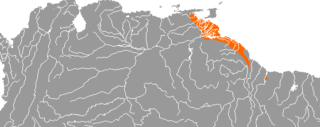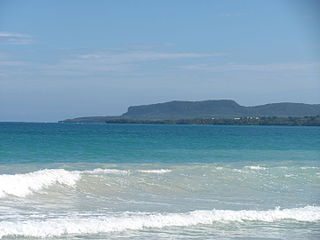
The Arawak are a group of Indigenous peoples of northern South America and of the Caribbean. Specifically, the term "Arawak" has been applied at various times from the Lokono of South America to the Taíno, who lived in the Greater Antilles and northern Lesser Antilles in the Caribbean. All these groups spoke related Arawakan languages.
The Lucayan people were the original residents of The Bahamas and the Turks and Caicos Islands before the European colonisation of the Americas. They were a branch of the Taínos who inhabited most of the Caribbean islands at the time. The Lucayans were the first Indigenous Americans encountered by Christopher Columbus. Shortly after contact, the Spanish kidnapped and enslaved Lucayans, with the displacement culminating in the complete eradication of the Lucayan people from the Bahamas by 1520.

The Ciboney, or Siboney, were a Taíno people of Cuba, Jamaica, and the Tiburon Peninsula of Haiti. A Western Taíno group living in Cuba during the 15th and 16th centuries, they had a dialect and culture distinct from the Classic Taíno in the eastern part of the island, though much of the Ciboney territory was under the control of the eastern chiefs. Confusion in the historical sources led 20th-century scholars to apply the name "Ciboney" to the non-Taíno Guanahatabey of western Cuba and various archaic cultures around the Caribbean, but this is deprecated.

The Lucayan Archipelago, also known as the Bahamian Archipelago, is an island group comprising the Commonwealth of The Bahamas and the British Overseas Territory of the Turks and Caicos Islands. The archipelago is in the western North Atlantic Ocean, north of Cuba and the other Antillean Islands, and east and south-east of Florida.

The Guanahatabey were an Indigenous people of western Cuba at the time of European contact. Archaeological and historical studies suggest the Guanahatabey were archaic hunter-gatherers with a distinct language and culture from their neighbors, the Taíno. They might have been a relic of an earlier culture that spread widely through the Caribbean before the ascendance of the agriculturalist Taíno.

Saona Island is a 110 square kilometer tropical island located off the south-east coast in Dominican Republic's La Altagracia province. It is a government-protected nature reserve and is part of Parque Nacional Cotubanamá.
At the time of first contact between Europe and the Americas, the Indigenous peoples of the Caribbean included the Taíno of the northern Lesser Antilles, most of the Greater Antilles and the Bahamas, the Kalinago of the Lesser Antilles, the Ciguayo and Macorix of parts of Hispaniola, and the Guanahatabey of western Cuba. The Kalinago have maintained an identity as an Indigenous people, with a reserved territory in Dominica.

A zemi or cemi was a deity or ancestral spirit, and a sculptural object housing the spirit, among the Taíno people of the Caribbean. Cemi’no or Zemi’no is a plural word for the spirits.

The Bahoruco Mountain Range—Sierra de Bahoruco is a mountain range located in the far southwestern region of the Dominican Republic. It is within Pedernales, Independencia, Barahona, and Bahoruco Provinces. A large part of the area is protected within the Sierra de Bahoruco National Park, also a Biosphere reserve.
The Ortoiroid people were the second wave of human settlers of the Caribbean who began their migration into the Antilles around 2000 BCE. They were preceded by the Casimiroid peoples. They are believed to have originated in the Orinoco valley in South America, migrating to the Antilles from Trinidad and Tobago to Puerto Rico. The name "Ortoiroid" comes from Ortoire, a shell midden site in southeast Trinidad. They have also been called Banwaroid, after another archaeological site in Trinidad.

Warao is the native language of the Warao people. A language isolate, it is spoken by about 33,000 people primarily in northern Venezuela, Guyana and Suriname. It is notable for its unusual object–subject–verb word order. The 2015 Venezuelan film Gone with the River was spoken in Warao.

Taíno is an extinct Arawakan language that was spoken by the Taíno people of the Caribbean. At the time of Spanish contact, it was the most common language throughout the Caribbean. Classic Taíno was the native language of the Taíno tribes living in the northern Lesser Antilles, Puerto Rico, the Turks and Caicos Islands, and most of Hispaniola, and expanding into Cuba. The Ciboney dialect is essentially unattested, but colonial sources suggest it was very similar to Classic Taíno, and was spoken in the westernmost areas of Hispaniola, the Bahamas, Jamaica, and most of Cuba.

Several languages of the Greater Antilles, specifically in Cuba and Hispaniola, appear to have preceded the Arawakan Taíno. Almost nothing is known of them, though a couple recorded words, along with a few toponyms, suggest they were not Arawakan or Cariban, the families of the attested languages of the Antilles. Three languages are recorded: Guanahatabey, Macoris, and Ciguayo.

The Taíno were a historic Indigenous peoples of the Caribbean, whose culture has been continued today by Taíno descendant communities and Taíno revivalist communities. At the time of European contact in the late 15th century, they were the principal inhabitants of most of what is now Cuba, the Dominican Republic, Jamaica, Haiti, Puerto Rico, the Bahamas, and the northern Lesser Antilles. The Lucayan branch of the Taíno were the first New World peoples encountered by Christopher Columbus, in the Bahama Archipelago on October 12, 1492. The Taíno spoke a dialect of the Arawakan language group. They lived in agricultural societies ruled by caciques with fixed settlements and a matrilineal system of kinship and inheritance. Taíno religion centered on the worship of zemis.

The Kalinago language, also known as Igneri, was an Arawakan language historically spoken by the Kalinago of the Lesser Antilles in the Caribbean. Kalinago proper became extinct by about 1920 due to population decline and colonial period deportations resulting in language death, but an offshoot survives as Garifuna, primarily in Central America.

Macorix was the language of the northern coast of what is today the Dominican Republic. Spanish accounts only refer to three languages on the island: Taíno, Macorix, and neighboring Ciguayo. The Macorix people appear to have been semi-sedentary and their presence seems to have predated the agricultural Taíno who came to occupy much of the island. For the early European writers, they shared similarities with the nearby Ciguayos. Their language appears to have been moribund at the time of the Spanish Conquest, and within a century it was extinct.

Ciguayo (Siwayo) was the language of the Samaná Peninsula of Hispaniola at the time of the Spanish Conquest. The Ciguayos appear to have predated the agricultural Taíno who inhabited much of the island. The language appears to have been moribund at the time of Spanish contact, and within a century it was extinct.

The Ciguayos were a group of Indigenous people who inhabited the Samaná Peninsula and its adjoining regions in the present-day Dominican Republic. The Ciguayos appear to have predated the agricultural Taíno who inhabited much of the island. Ciguayo was spoken on the northeastern coast of the Magua region from Nagua southward to at least the Yuna River, and throughout all of the Samana Peninsula.
Waroid is a proposal by Granberry and Vescelius (2004) linking Warao of Venezuela with the extinct Macoris and Guanahatabey languages of the Greater Antilles.










